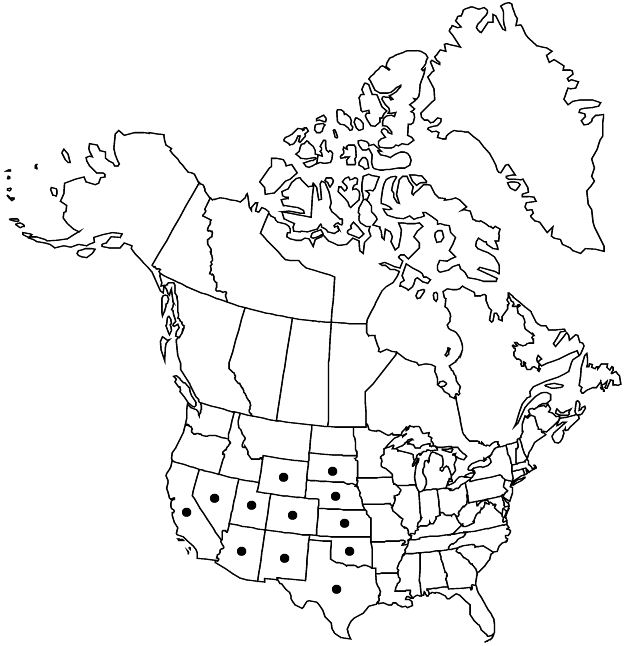Euphorbia fendleri
in War Department [U.S.], Pacif. Railr. Rep. 2(4): 175. 1857.
Herbs, perennial, with woody, thickened taproot. Stems usually prostrate, decumbent, or ascending, very rarely erect, often densely clustered from top of woody crown, 5–12 cm, glabrous. Leaves usually opposite, rarely whorled; stipules distinct, narrowly linear, 0.5–1 mm, glabrous; petiole 0.5–1 mm, glabrous; blade usually orbiculate to ovate, rarely almost lanceolate, 3–8 × 2.5–7 mm, base slightly asymmetric, slightly cordate to rounded or obtuse, margins entire, apex rounded to obtuse, surfaces glabrous; obscurely 3–5-veined from base, only midvein conspicuous. Cyathia solitary at distal nodes; peduncle 0.7–1.2 mm. Involucre campanulate to turbinate or broadly cupulate, 1.1–1.7 × 1.2–1.8 mm, glabrous; glands 4, yellow-green to reddish, elliptic to oblong, 0.2–0.5 × 0.4–0.9 mm; appendages absent or white, rarely pink, often unequal, lunate to flabellate or sometimes forming crenate margin along gland, (0–)0.1–0.6 × (0–)0.5–1.5 mm, distal margin entire or toothed. Staminate flowers 25–35. Pistillate flowers: ovary glabrous; styles 0.3–0.4 mm, 2-fid 1/2 length. Capsules depressed-globose, 2–2.4 × 2.2–2.5 mm, glabrous; columella 1.7–2.1 mm. Seeds white, ovoid-pyramidal, prominently 4-angled in cross section, 1.7–2 × 1–1.2 mm, smooth to slightly wrinkled. 2n = 28.
Phenology: Flowering and fruiting spring–fall.
Habitat: Mountain slopes, desert scrub, pinyon-juniper woodlands, hills, canyons, grasslands, washes, roadsides, dry crevices in limestone, often in gravel and sand.
Elevation: 500–2600 m.
Distribution

Ariz., Calif., Colo., Kans., Nebr., Nev., N.Mex., Okla., S.Dak., Tex., Utah, Wyo., Mexico (Coahuila).
Discussion
Euphorbia fendleri is similar to E. chaetocalyx and may sometimes be confused with that species. Its prostrate to decumbent or ascending stems and small, ovate to orbiculate leaves distinguish it from E. chaetocalyx. Some authors have used the presence or absence and shape of the involucral gland appendages to help separate E. fendleri from E. chaetocalyx, but those characters appear highly variable and of little taxonomic utility; somewhat intermediate individuals occur in western Arizona, New Mexico, and Texas.
Selected References
None.